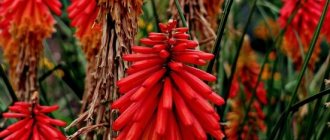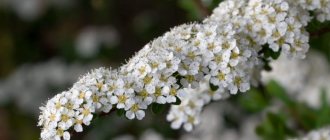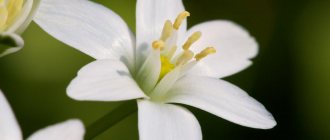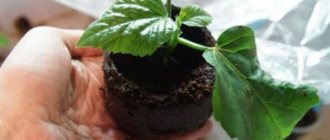The milky white corydalis flowers are much more beautiful than most other flowers because they have a larger and wider lip. The 10 or more flowers per stem also grow tightly together - possibly because the species has twice the normal number of chromosomes.
Author of the article
Eduard Dmitriev
Florist and lover of indoor and garden plants.
Thus, although the height of the corydalis is about 20 centimeters, one plant will have an impact on the overall appearance of the garden. In the wild, tuberous corydalis grows in the North Caucasus and in the upper reaches of two river valleys - Kuban and Malka.
Description
The name Corydalis comes from the Greek korydalis, which means crested lark, in reference to the shape of the flowers. There are about 450 species, 330 of which are native to China and Tibet. Some varieties are found in Sweden, southern Finland, the Urals, central Europe, Spain and Greece. But the red and pink forms are mainly found in the mountainous region of Transylvania in Romania.
They vary greatly from high alpine (suitable for rocky ground or alpine terrain), to forest and herbaceous plants. They are members of the poppy family and are related to dicentras and fumiori.
General information
Corydalis takes its name from korydallion, the Greek name for the crested lark, and it is loosely related to the shape of the flower.
It is quite difficult to pronounce the scientific name of these flowers and therefore they have many different “folk” names. The flower's tendency to self-sow should not be a problem if it is positioned correctly in the garden.
How does Corydalis (flower) reproduce?
A description of propagation methods will help you grow wonderful flowers in your flowerbed. If you want to have corydalis in your garden, you can simply replant the plant from the forest, the main thing is to leave a large lump of earth. When digging up a flower, do not forget that its roots are quite deep. Corydalis can also reproduce using seeds.
In cultivation, plants run wild, spreading over long distances from the planting site. Quite often, ants carry seeds to a variety of places. Corydalis are usually found in the shade of trees, where the ground is covered with fallen leaves. Since flowering begins very early, they do not in any way interfere with the growth of other crops.
In nature, the corydalis chooses places in the forest with humus soil, and in culture it takes root in ordinary soil. Excessive moisture, bright lighting and turfy soil are harmful to it.
Growing
Some species of corydalis can be quite finicky, especially species from high altitudes, because they need dry summer weather. But the tuberous and rhizomatous forms found naturally in forests (such as C. malkensis, C. solida and C. anthriscifolia) survive in the garden year after year, given good soil and growing in partial shade. Don't let them dry out in the spring.
The longer the plant remains in its leaves after flowering, the more nutrients will be retained for the following year. Plant plants in partial shade in a woodland environment and they will be protected from too much sun.
C. solida and C. malkensis go underground by early summer. Mark their positions with marks if you need to. To propagate, lift C. malkensis tubers when they are dormant between June and late August. Divide them and replant them in the garden.
Prefers moist, well-drained, fairly light soil, in partial shade. Grows well in a forest garden or peat bog. Plants that are immune to rabbits and hares.
Most tuberous plants need good drainage. However, Corydalis differs from many in that it does not appreciate hot, open sun. Plant them in partial shade where the soil remains cool and moist. A strong plant should grow twice as large every year. Watering the soil with diluted fertilizer soon after shoots emerge promotes good tuber growth.
general information
The herbaceous corydalis is distributed throughout the Northern Hemisphere and is perfectly adapted to our climate. It blooms early and very profusely, is famous for its healing properties and is completely unpretentious.
Corydalis stems rarely grow above 45 cm, but the root system is surprisingly powerful and branched. It goes deep underground and is covered with tuberous growths, which ensures such plant endurance, and at the same time helps perennial varieties to overwinter.
The carved leaves of the corydalis resemble a miniature fern. Against the background of their silvery-bluish bloom, the racemose inflorescences look even brighter. Each contains up to 35 tubular bells in all shades of white, yellow, pink and purple. Corydalis blooms in April.
All types of corydalis are used in folk medicine. Young leaves can also be used for culinary purposes. The delicate aroma of the flowers attracts beneficial insects, and in general the corydalis is a good honey plant.
Photo: zen.yandex.ru
Distribution of Corydalis
Seeds - best sown as soon as they are ripe, they will die quickly if allowed to dry out. The surface of the sandbank is sown and kept moist, usually the corydalis germinates in 1 - 3 months at 15 degrees Celsius.
Two months of warmth and further cold stratification improve the germination of stored seeds. Sow the seeds in a thin line to allow the seedlings to grow in the pot during their first year. Apply liquid fertilizer at intervals during the growing season to keep the flowers well nourished.
Seedlings produce only one leaf in the first year of growth and are very prone to rotting. Divide the seedlings into individual pots once they have gone dormant, and grow them in a partially shaded area of the greenhouse for at least another year. Place them in permanent locations when they are resting. Dividing should be done immediately after flowering.
Diseases and pests of corydalis
Corydalis has excellent immunity, and therefore diseases occur quite rarely. As mentioned above, when water stagnates in the soil, rot may form. This is fraught with the loss of the entire flower, since rot affects, in this case, the root system.
As for viruses, many crops are susceptible to them, including corydalis. It is important to detect the infestation in time and immediately remove the infected areas of the plant. As a rule, the affected parts are burned, and the growth site is thoroughly disinfected by treating with a solution of potassium permanganate. It must be strong enough and rich enough to eliminate any viruses that may remain in the soil.
If a fungal infection occurs, fungicides are used.
The list of pests is quite modest: only mice and moles are dangerous. They are easy to fight with the help of special poisoned baits.
Landscape use
Ideal partners are the taller green and white tulip viridiflora 'Spring Green' and small blue bulbs such as Scilla siberica. Or plant corydalis among hardy ferns. In slightly sunnier conditions they can be combined with the March flowering Dutch crocus.
These spring flowering plants disappear by late spring or early summer. You can use other flowering plants that die out in winter such as hardy geraniums.
They also look very good at the front of the garden with crocuses, in front of dicentras or with miniature bulbs. They can also be grown in pots with sandy soil, but keep the compost cool and moist in summer.
Planting corydalis in open ground
When to plant corydalis
Tubers for planting are usually purchased from the beginning of summer until September, inclusive. At the same time, it is recommended to plant corydalis in open ground. Purchased tubers must be carefully inspected. Suitable tubers are juicy, strong, dense. Slight dryness of tubers does not have a harmful effect exclusively on species characteristic of Central Asia.
Requirements for the planting site of corydalis are determined depending on the type of plant purchased. Thus, forest corydalis love places without bright sunlight, with loose soils. And Chinese and Alpine prefer a lot of sunlight, sandy loam soils, with good drainage. As for the acidity level of the soil, neutral or slightly acidic is ideal.
How to plant corydalis
Planting corydalis in open ground is a simple process and will not take much time. Of course, you need to take into account the condition of the soil. In some cases, digging is carried out. For example, crushed stone or gravel (only fine) is added to dense, heavy soils.
Important! When planting corydalis, you should think in advance about creating a drain for excess water, since plants do not like excess moisture: rot may appear.
The depth of the tubers directly depends on their size. So, small tubers are placed at a level of 5 to 7 cm in depth, larger ones - at a depth of 10 to 15 cm. After planting, moderate watering is required.
Medicinal use
Always seek the advice of a professional before using any plant for medicinal purposes. Corydalis tuber is antispasmodic, hallucinogenic, and also slows the pulse. It is collected in the spring before the plant blooms and dried for later use.
The plant should only be used under the guidance of a physician and is used to treat Parkinson's disease and other neurological disorders. One report states that the plant is cultivated for medicinal use in Sweden. The tuber of the “Yanhusuo” variety has an analgesic, antiseptic, antispasmodic and sedative effect.
The root has traditionally been used to reduce pain and increase circulation. It also has sedative properties and is used in the treatment of a wide range of diseases. Various plant extracts exhibit antitussive, cardiotonic, hypotensive and antitumor activity.
Beneficial features
Only corydalis tubers are suitable for medicinal purposes; they can be harvested only after fruiting. They need to be cut into thin slices and dried. The remaining parts will not be needed because they contain toxic substances.
Preparations made from plant tubers have an analgesic and antispastic effect, which is why they are used for arterial hypertension, seizures, intestinal diseases and Parkinson's disease. In addition, Corydalis officinalis has anti-inflammatory, hemostatic, antioxidant and hypnotic effects, and normalizes hormonal levels in the weaker half of humanity.
Varieties
Typically, the soft shade of blue-green, compound leaves gives the plant a soft, airy feel that contrasts nicely with shaded plants with rougher textures.
In spring and early summer, corydalis displays clusters of small, showy flowers above the foliage. The wide range of flower shades - creamy white, yellow, purple, pink, red and blue - is somewhat unusual for shade-loving plants.
Corydalis grows best in humus-rich, consistently moist but well-drained soil. It also enjoys slightly sun-dappled conditions that resemble forests, especially in hot summer climates.
Closer to the south, the growth of this plant may slow down or even stop. On the other hand, in cool summer climates, corydalis can bloom all summer long. Too much shade results in lanky plants and infrequent flowering. If there is an excessive amount of moisture, rotting is possible.
Previously, in another article, we talked about the perennial flower – Hellebore.
Most species enthusiastically disperse on their own, sometimes to the point that they are considered weeds. Young seedlings are easy to remove and transplant to more desirable locations. In the spring, divide the root balls every two to three years, keeping in mind that the corydalis does not like to be disturbed in later life.
Variety “Berry Exciting”
This variety of Corydalis has golden ferny leaves that produce purple flowers. In the summer heat, this variety rests.
Variety "Beth Evans"
It has beautiful bright pink flowers that soften to light pink with age. Tuberous variety.
Variety “Blackberry Wine”
This variety has fragrant, wine-purple, tubular flowers. Blooms from late spring to early summer or longer in cool climates.
Variety “Blue Corydalis“
Corydalis elata, at 40-45 centimeters in flower, is taller than other blue varieties. Its cobalt blue inflorescences form a little later, and the plant is less likely to go dormant in the summer.
Variety “Blue Panda“
Corydalis flexuosa, like other species, produces elongated blue flowers with spurs in spring. It goes to sleep in midsummer, but returns once again before wintering. Its name is due to its origin in China.
Variety “Canary Feathers“
This variety of Corydalis is a hybrid that has blue-green feather-like leaves and blooms in spring and summer with sporadic blooms in late summer and fall.
Variety “Chinese blue”
Corydalis flexuosa is an outstanding aromatic species. Mulch the soil to keep it cool and moist; this variety can rest in high temperatures in summer.
Variety “Corydalis lutea“
The variety Corydalis lutea blooms from spring to autumn. Although short-lived, it germinates easily to make a flowering addition to a shade garden.
Variety “Corydalis ochroleuca“
Corydalis ochroleuca is native to the rocky forests of Europe. It grows and disperses on its own in rock walls and other well-drained areas. Milky white flowers with yellow throats grow on blue-green ferny foliage.
Variety “Purple Leaf“
Corydalis flexuosa appears in early spring and has clusters of blue flowers above purple foliage. In regions with warm weather, he will rest in the summer.
Common varieties
First of all, it is worth considering forest species of Corydalis with a short growing season, that is, related to ephemeroids, like many primroses. They use the time when in the spring the deciduous forest does not yet provide shade. From April to the end of June they have time to bloom, produce offspring and disappear, leaving renewal buds on the nodules underground.
In our middle zone, these are dense corydalis or Haller, Marshall and hollow corydalis (Corydalis cava). All grow from yellow nodules up to 2-3 cm in diameter.
- The first of them, Hallera reaches 15-25 cm, blooms with pink-violet tassels, green bracts. It is often found in the forests of Europe, in open forests and on the edges of deciduous forests of our country, except in the extreme northern regions. Absolutely frost-resistant. Propagated by seeds and division of tubers. Many of its varieties come from wild forms.
George Baker, Zwanenburg – with red colors. They bloom from early May to late June. Tubers can be divided once every three years. When grown from seeds, they are pollinated with other varieties, resulting in a mixture of colors. Therefore, it is recommended to remove flower stalks with green seeds.
Beth Evans - with pink flowers. Propagated by dividing tubers, blooms in early spring:
Blue Topaz, Blue Dream, Blue Pearl - deep blue, very impressive:
There are varieties with white and salmon combined colors. - Marshall's Corydalis is found in the black earth zone of Russia. It blooms in spring with light yellow flowers with green bracts. Peduncle stems with a red tint. The flowers are larger than those of the dense one, up to 4 cm long.
- The hollow corydalis can withstand more shady places, it is taller than the previous ones, reaching 30-35 cm. The flowers are violet-pink, the bract is purple. There are white specimens.
If Marshall and hollow corydalis are planted nearby, they can cross-pollinate and the resulting forms (not varieties) are white-pink, or white with a yellowish tint. In these two species, the tubers are perennial, become hollow over time, and young ones are born inside.
It is preferable to plant rowan trees of forest varieties in lightly shady areas, as they require less care, if not none. These also include Bush's corydalis, Caucasian and others.
High mountain require more attention . Of these, the most unpretentious are Kashmir, Darwaz and Holostalk. In landscape design, they are allocated elevated places, for example, on an alpine hill with good drainage without stagnant water. Their natural habitats are rocky mountain slopes and screes.
Photo of Kashmiri koridalis:
Only in the Kashmir and Bush corydalis, “babies” are formed on the side surface of the tuber by autumn - small nodules of up to 8 pieces on each.
Plant species
Host Type
This plant, barely grown 40 years ago, is now one of the most commonly grown garden plants. But hostas have earned their place in gardeners' hearts - they are one of the easiest plants to grow if you have shade and good rainfall.
Hostas range from tiny plants suitable for depressions or rock gardens to massive meter-long clumps with heart-shaped leaves that can be crinkled, wavy-edged, white or green, blue-gray, chartreuse, emerald-edged - the variations are virtually endless.
Hostas of new sizes showing foliage features seem to appear every year. Also known as the common lily, this tough, shade-loving perennial blooms in summer with white or purple-lavender trumpet-shaped or fluffy flowers. Some of them are very fragrant. Hostas are favorites of slugs and deer.
View of Barrenwort
The Barrenwort variety is a rare plant that grows in dry shade under shallow-rooted trees. It spreads at a moderate rate, forming an elegant, dense ground cover. It also produces graceful flowers in the shape of a bishop's miter - taking on another common name, bishop's cap. Its colorful foliage dangles on thin stems, giving it another nickname: fairy wings.
Classification[ | ]
Taxonomy[ | ]
Genus Corydalis
belongs to the family Fumariaceae
of
the order
Ranunculales
.
In a number of sources, this genus is placed in the Poppy family ( Papaveraceae
)[2].
| 7 more families (according to the APG II System) | ||||||||||||
| about 585 species | ||||||||||||
| order Ranunculaceae | genus Corydalis | |||||||||||
| Department Flowering, or Angiosperms | Dymyankov family | |||||||||||
| 44 more orders of flowering plants (according to the APG II System) | about 20 more births | |||||||||||
Types[ | ]
Flowers of Corydalis solida
(left) and
Corydalis cava
(right)
Main article: Species of the genus Corydalis
The total number of species is about 585[4], some of them:
- Corydalis aitchisonii Popov
- Corydalis alexeenkoana N.Busch
- Corydalis alpestris CAMey. — Alpine corydalis
- Corydalis ambigua Cham. & Schltdl. — Corydalis is deceptive
- Corydalis angustifolia (M.Bieb.) DC. — Corydalis angustifolia
- Corydalis bracteata (Steph. Willd.) Pers. — Corydalis grandiflora
- Corydalis bucharica Popov
- Corydalis buschii Nakai
- Corydalis capnoides () Pers. — Corydalis fume-shaped
- Corydalis caucasica DC. — Caucasian corydalis
- Corydalis cava () Schweigg. & Korte – Hollow corydalis
- Corydalis chionophila Czerniak. — Snow-loving corydalis
- Corydalis conorhiza Ledeb. — Corydalis conical root
- Corydalis darwasica Regel Prain
- Corydalis emanuelii CAMey. — Emanuel's Corydalis
- Corydalis erdelii Zucc. — Corydalis Erdeli
- Corydalis fedtschenkoana Regel
- Corydalis fimbrillifera Korsh. — Corydalis fringed petal
- Corydalis fumariifolia Maxim. — Corydalis fume-leaved
- Corydalis ×gigantea Trautv. & CAMey. — Giant corydalis
- Corydalis glaucescens Regel
- Corydalis gortschakovii Schrenk
- Corydalis impatiens (Pall.) Fisch. DC. — Corydalis impatiens
- Corydalis inconspicua Bunge Ledeb. — Corydalis inconspicuous
- Corydalis intermedia () Mérat
- Corydalis kashgarica Rupr. — Kashgar corydalis
- Corydalis ledebouriana Kar. & Kir. — Ledebour's Corydalis
- Corydalis macrantha (Regel) Popov
- Corydalis macrocalyx Litv. — Corydalis large-cupped
- Corydalis macrocentra Regel
- Corydalis nobilis () Pers. — Corydalis nobilis
- Corydalis nudicaulis Regel
- Corydalis ochotensis Turcz. — Corydalis of Okhotsk
- Corydalis paeoniifolia (Steph.) Pers. — Corydalis peonyfolia
- Corydalis pallida (Thunb.) Pers. — Pale corydalis
- Corydalis pallidiflora (Rupr.) N.Busch
- Corydalis paniculigera Regel & Schmalh. — Corydalis paniculata
- Corydalis pauciflora (Steph. Willd.) Pers. — Corydalis pauciflora
- Corydalis persica Cham. & Schltdl. — Persian corydalis
- Corydalis popovii Nevski Popov
- Corydalis pseudoadunca Popov
- Corydalis pseudoalpestris Popov
- Corydalis pseudostricta Popov
- Corydalis raddeana Regel
- Corydalis repens Mandl & Muhldorf - Creeping corydalis
- Corydalis schelesnowiana Regel & Schmalh. — Khokhlatka Zheleznova
- Corydalis semenowii Regel & Herder
- Corydalis sibirica (Lf) Pers. — Siberian corydalis
- Corydalis stricta Steph. DC. — Corydalis straight
- Corydalis solida () Clairv. — Corydalis dense
- Corydalis transalaica Popov
Common Corydalis (Corydalis remota)
The corydalis (Corydalis remota) is found in mixed forests of the Far East and Eastern Siberia; similar to the previous view. The plant is about 10 cm high. The flowers are blue-blue, purple along the edges of the petals, open in April. The stem is thin, often creeping. The leaves are miniature.
Common Corydalis (Corydalis remota)
Magadan Corydalis (Corydalis magadanica)
Magadan Corydalis (Corydalis magadanica) is an endemic species that grows on the coastal slopes in the vicinity of Magadan. The plant is about 12 cm high; Blooms in May-June with white or pale pink flowers. The tubers are small, about 10 mm in diameter.
Magadan Corydalis (Corydalis magadanica)
Low Corydalis from mountain-steppe regions can be recommended for growing on rocky hills:
Corydalis schanginii (Corydalis schanginii)
Corydalis schanginii (Corydalis schanginii) is a miniature species with a height of about 10 cm. It is found locally in the Caspian region (Mangyshlak), Kazakhstan and the southern part of Western Siberia. It blooms in the second half of April with soft purple flowers with a purple eye, collected in long, almost horizontally arranged inflorescences. Leaves with a bluish tint. Plant tubers in sunny places.
Corydalis schanginii (Corydalis schanginii)
Corydalis ambigua (Corydalis ambigua)
Corydalis dubious (Corydalis ambigua) grows in the forests of the Far East. Prefers light leafy soil and shade during the growing season. The plant is about 20 cm high and blooms in mid-April with large bluish flowers. The bulbs are very small, like a pea. This species goes well with corydalis, which have reddish flowers.
Corydalis ambigua (Corydalis ambigua)
Severtsov's Corydalis (Corydalis sewerzowii)
Severtsov's Corydalis (Corydalis sewerzowii) is found on the clayey slopes of the mountains of the western Tien Shan. Introduced into cultivation by the St. Petersburg Botanical Garden in 1882. It blooms with bright yellow or orange flowers in April. Propagates well by seeds and vegetatively.
Severtsov's corydalis (Corydalis sewerzowii)
Rhizome species are of significant interest to collectors.
Notes[ | ]
- For the convention of indicating the class of dicotyledons as a superior taxon for the group of plants described in this article, see the section “APG Systems” of the article “Dicotyledons”.
- ↑ 123
According to the GRIN website (see plant card). - Soviet encyclopedic dictionary. M., Soviet Encyclopedia, 1990, P. 1477.
- List of species of the genus Corydalis according to the website The Plant List (2013) (English) (Latin) (Date of access: October 3, 2016)
- Rubinina A.
Early song of corydalis // Flower beds. - 2011. - No. 3. - P. 34-35. - Royal General Bulbgrowers' Association. International Society for Horticultural Science. Retrieved May 30, 2013. Archived May 30, 2013.
- De database Geregistreerde cultivars (English) (inaccessible link). Royal General Bulbgrowers' Association. Access date: May 30, 2013. Archived July 4, 2009.
Marshall's Corydalis (Corydalis marschalliana)
Marshall's Corydalis (Corydalis marschalliana) grows in sparse forests of the Caucasus and the European part of the CIS. Plant 20 cm high; blooms in early April. The leaf segments are oblong. Flowers with a long spur are straw-yellow or light yellow, not numerous; collected in large, vertically directed brushes.
Marshall's Corydalis (Corydalis marschalliana)
Corydalis paczoskii
Paczoskii's Corydalis (Corydalis paczoskii) is one of the most interesting Corydalis in my collection. Found in Crimea. At the beginning of the growing season, the reddish stems of this corydalis almost lie on the surface of the soil. During flowering, a small brush about 8 cm high, consisting of 9 large light lilac flowers, rises upward. The spur of the flower is lilac, the eye is purple. This corydalis blooms in mid-April. The tubers are small and brown. Combines well with the white-flowered forms of other corydalis species.
Corydalis paczoskii
Ledebur's Corydalis (Corydalis ledebuurii)
Ledebur's Corydalis (Corydalis ledebuurii) is a typical mountain species found in Central Asia, in the Hindu Kush. In culture since 1880. The plant is about 13 cm high; blooms at the end of April. The flowers are pale pink, collected in an inflorescence. The spur is pink, the eye is gray with a white spot. An adult tuber reaches a weight of 190 grams and produces up to 17 peduncles.
Ledebur's Corydalis (Corydalis ledebuurii)











